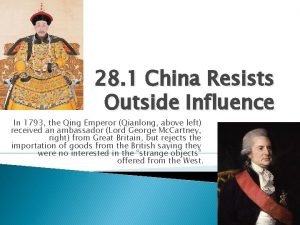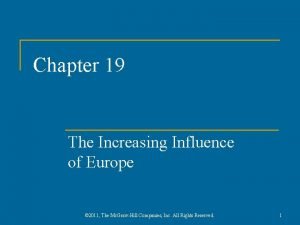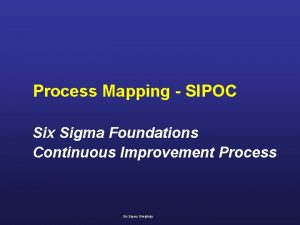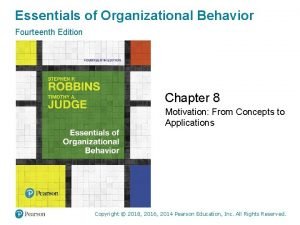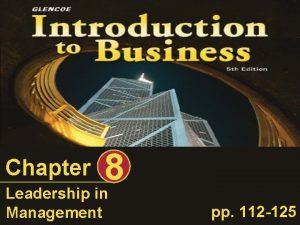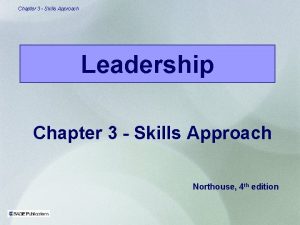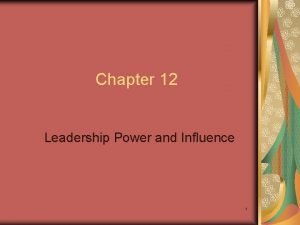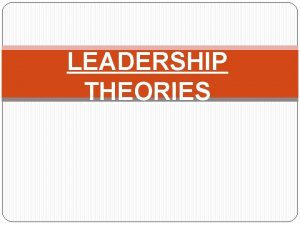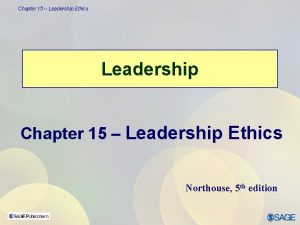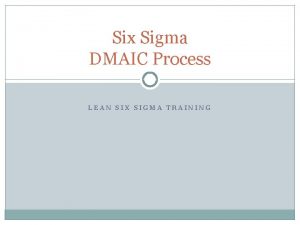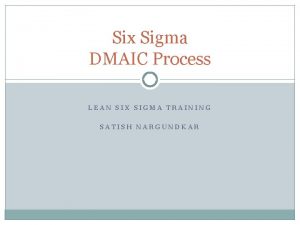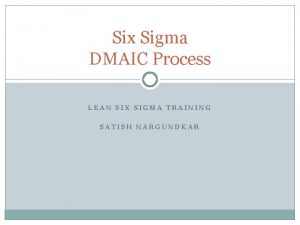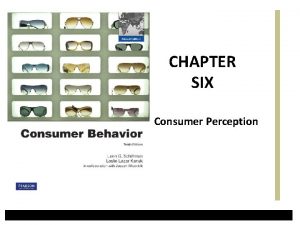Chapter Six Leadership as an Influence Process Mc





















- Slides: 21

Chapter Six Leadership as an Influence Process Mc. Graw-Hill/Irwin Copyright © 2011 by The Mc. Graw-Hill Companies, Inc. All rights reserved.

Figure 6. 1 The Leader Power—Follower Response Relationship 6 -2

Reading 12 The Bases of Social Power § The phenomena of power and influence involve a dyadic relation between two agents § What determines the behavior of the agent who exerts power? § What determines the reactions of the recipient of this behavior? § P is the person upon whom power is exerted 6 -3

Reward Power § It depends on O’s ability to administer positive valences and to remove negative valences § The utilization of actual rewards (instead of promises) by O will tend over time to increase the referent power of O over P § The range of reward power is specific to those regions within which O can reward P for conforming 6 -4

Coercive Power § This power stems from the expectation of P that he will be punished by O if he fails to conform to the influence attempt § Coercive power leads to dependent change § Reward power will tend to increase the attraction of P toward O; coercive power will decrease this attraction 6 -5

Legitimate Power § This power stems from internalized values in P which dictate that: § O has a legitimate right to influence P § P has an obligation to accept this influence § Bases for legitimate power § Cultural values § Acceptance of the social structure § Designation by a legitimizing agent 6 -6

Legitimate Power § Range of legitimate power of O/P § Areas in which legitimate power may be exercised are specified along with the designation of that power § The use of legitimate power which is outside the range of legitimate power will decrease the power of the authority figure § Legitimate power and influence § The system which results from legitimate power usually has high dependence on O though it may become independent 6 -7

Referent Power § The referent power of O/P has its basis in the identification of P with O § A feeling of oneness of P with O § O has the ability to influence P, even though P may be unaware of this referent power § The basic distinction between referent power and both coercive and reward power is the mediation of the punishment and the reward by O 6 -8

Expert Power § The strength of the expert power of O/P varies with the extent of the knowledge or perception which P attributes to O within a given area § Expert power results in primary social influence on P’s cognitive structure and probably not on other types of systems § The range of expert power is more delimited than that of referent power § The expert is seen as having superior knowledge or ability in very specific areas 6 -9

Reading 13 Relationships between Leader Reward and Punishment Behavior and Group Processes and Productivity § Understanding the relationship between leaders and groups is important because: § Leaders emerge from groups § Leaders determine goals of groups § Leaders are influenced by groups § Two general classes of leader behavior that seem to be relevant to group processes and productivity are: § Leader reward § Punishment behaviors 6 -10

Leader Behavior and Group Cohesiveness § Byrne has hypothesized that we: § Are attracted to those individuals or groups in whose presence we receive rewards § Are not attracted to those individuals or groups in whose presence we are punished § Leader contingent reward behavior is: § Positively related to perceptions of group cohesion § Negatively related to this criterion variable 6 -11

Leader Behavior And Group Drive § Zander views the group’s aspiration level to be a function of individual group members’ perceptions of the probability that the group will be able to achieve success and avoid failure § Leader contingent reward and contingent punishment behavior is positively related to group members’ perceptions of group drive § Leader noncontingent reward and noncontingent punishment behavior is not related to group drive 6 -12

Leader Behavior and Group Productivity § Stogdill has reported that group drive is positively related to group productivity § Zander has noted that group drive may result in group productivity when group members are provided with accurate performance feedback § Group members’ perceptions of: § Leader contingent reward and punishment behaviors is positively related to their perceptions of group productivity § Leader noncontingent reward and punishment behaviors is not related to the perceptions of group productivity 6 -13

Assumptions Underlying Expectations § Respondents in the present study are in functioning groups § No competition or work-flow interdependence exists among group members 6 -14

Discussion and Conclusions § Leaders who reward individuals appropriately also reward the group as a whole when it performs well or succeeds on a task § Several studies suggest that: § Individually administered monetary rewards are more effective when the tasks subordinates perform are independent § Rewards based on group performance are more effective when tasks are additive or require cooperation 6 -15

Discussion and Conclusions § There is a consistent positive relationship between contingent punishment behavior and group drive and productivity § Leaders who administer evaluative rewards and punishments contingently will have a more functional effect on: § Subordinate performance and satisfaction § Group outcomes 6 -16

Reading 14 Cooperation as a Function of Leader Self-Sacrifice, Trust, and Identification § One of the core functions of leadership is to motivate individuals to cooperate towards collective goals § Leaders’ ability to motivate individuals beyond self-interest is of key importance to the effectiveness of groups and organizations § Trust in the leader plays an important role in mediating the effects of leader self-sacrifice on follower cooperation 6 -17

Leader Self-sacrifice, Trust in the Leader, and Follower Cooperation § Self sacrificing leaders, compared with self-benefiting leaders, are better able to motivate group members to cooperate with the collective § A key process that plays a role in explaining the psychology of self sacrificing leadership is trust in the leader § A trustworthy leader communicates that the intentions of the leader in the future will be fair and honest 6 -18

The Present Study § Hypotheses used in study 1 § H 1 - A self-sacrificing leader elicits more cooperation than a self-benefiting leader § H 2 - A self-sacrificing leader elicits more trust than a selfbenefiting leader § H 3 - Trust in the leader mediates the effect of self-sacrifice on cooperation § Hypotheses used in study 2 § H 4 - A self-sacrificing leader promotes collective identification more than a self benefiting leader § H 5 - Collective identification mediates the effect of selfsacrifice on cooperation 6 -19

Discussion § Leader self-sacrifice on behalf of the collective is an effective way to stimulate follower cooperation § Leader self-sacrifice was positively related to cooperation, and this relationship was mediated by followers’ trust in the leader § Charismatic and transformational leadership is positively related to follower identification 6 -20

Conclusion § Motivating individuals to go beyond self-interest and to cooperate towards collective goals and interests is of major importance for the internal functioning of groups and organizations § Self-sacrifice moves people beyond self-interest § There is still much to learn about leader self-sacrifice § Self sacrifice creates a “source of psychological comfort for the followers” 6 -21
 Steve jobs intellectual stimulation
Steve jobs intellectual stimulation A polygon with six congruent sides and six congruent angles
A polygon with six congruent sides and six congruent angles Transactional vs transformational leadership
Transactional vs transformational leadership Situational leadership vs adaptive leadership
Situational leadership vs adaptive leadership Situational leadership vs adaptive leadership
Situational leadership vs adaptive leadership Discuss the factors influencing communication
Discuss the factors influencing communication China resists outside influence chapter 28 section 1
China resists outside influence chapter 28 section 1 Chapter 19 the increasing influence of europe
Chapter 19 the increasing influence of europe Six sigma process map symbols
Six sigma process map symbols Six steps of troubleshooting
Six steps of troubleshooting The six step blueprint for process analysis begins with:
The six step blueprint for process analysis begins with: Download six sigma foundations
Download six sigma foundations Strip poker to kill a mockingbird
Strip poker to kill a mockingbird Chapter 12 leadership organizational behavior
Chapter 12 leadership organizational behavior Chapter 8 lotf summary
Chapter 8 lotf summary Organizational behavior chapter 8
Organizational behavior chapter 8 Chapter 8 leadership in management
Chapter 8 leadership in management Chapter 7 management and leadership
Chapter 7 management and leadership The skills approach is primarily
The skills approach is primarily Chapter 14 teamwork and leadership
Chapter 14 teamwork and leadership Interdepartmental dependency
Interdepartmental dependency Servant leadership northouse
Servant leadership northouse






